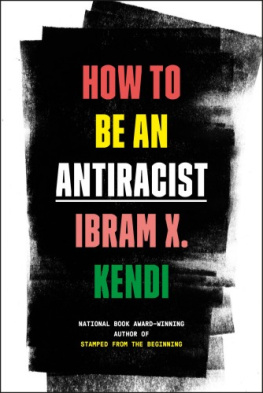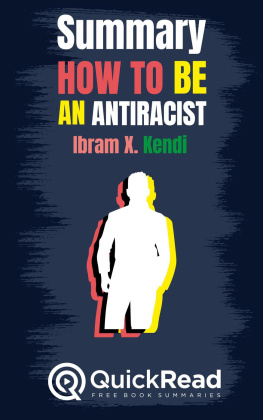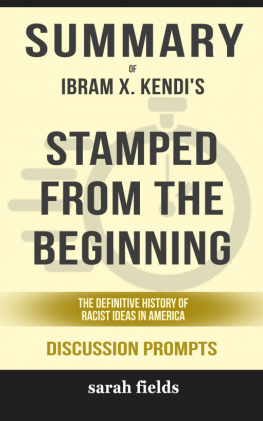

Copyright 2016 by Ibram X. Kendi
Published by Nation Books, A Member of the Perseus Books Group
116 East 16th Street, 8th Floor
New York, NY 10003
Nation Books is a co-publishing venture of the Nation Institute and the Perseus Books Group
All rights reserved. Printed in the United States of America. No part of this book may be reproduced in any manner whatsoever without written permission except in the case of brief quotations embodied in critical articles and reviews. For information, address the Perseus Books Group, 250 West 57th Street, 15th Floor, New York, NY 10107.
Books published by Nation Books are available at special discounts for bulk purchases in the United States by corporations, institutions, and other organizations. For more information, please contact the Special Markets Department at the Perseus Books Group, 2300 Chestnut Street, Suite 200, Philadelphia, PA 19103, or call (800) 810-4145, ext. 5000, or e-mail .
Designed by Jack Lenzo
Library of Congress Cataloging-in-Publication Data
Names: Kendi, Ibram X., author.
Title: Stamped from the beginning: the definitive history of racist ideas in America / Ibram X. Kendi.
Description: New York: Nation Books, 2016. | Includes bibliographical references and index.
Identifiers: LCCN 2015033671 | ISBN 9781568584645 (ebook: alk. paper)
Subjects: LCSH: RacismUnited StatesHistory. | United StatesRace relations.
Classification: LCC E185.61 .K358 2016 | DDC 305.800973dc23
LC record available at http://lccn.loc.gov/2015033671
10 9 8 7 6 5 4 3 2 1
To the lives they said dont matter
Table of Contents
Guide
Contents
EVERY HISTORIAN WRITES INand is impacted bya precise historical moment. My moment, this books moment, coincides with the televised and untelevised killings of unarmed human beings at the hands of law enforcement officials, and with the televised and untelevised life of the shooting star of #Black Lives Matter during Americas stormiest nights. I somehow managed to write this book between the heartbreaks of Trayvon Martin and Rekia Boyd and Michael Brown and Freddie Gray and the Charleston 9 and Sandra Bland, heartbreaks that are a product of Americas history of racist ideas as much as this history book of racist ideas is a product of these heartbreaks.
Young Black males were twenty-one times more likely to be killed by police than their White counterparts between 2010 and 2012, according to federal statistics. The under-recorded, under-analyzed racial disparities between female victims of lethal police force may be even greater. Federal data show that the median wealth of White households is a staggering thirteen times the median wealth of Black householdsand Black people are five times more likely to be incarcerated than Whites.
But these statistics should come as no surprise. Most Americans are probably aware of these racial disparities in police killings, in wealth, in prisonsin nearly every sector of US society. By racial disparities, I mean how racial groups are not statistically represented according to their populations. If Black people make up 13.2 percent of the US population, then Black people should make up somewhere close to 13 percent of the Americans killed by the police, somewhere close to 13 percent of the Americans sitting in prisons, somewhere close to owning 13 percent of US wealth. But today, the United States remains nowhere close to racial parity. African Americans own 2.7 percent of the nations wealth, and make up 40 percent of the incarcerated population. These are racial disparities, and racial disparities are older than the life of the United States.
In 2016, the United States is celebrating its 240th birthday. But even before Thomas Jefferson and the other founders declared independence, Americans were engaging in a polarizing debate over racial disparities, over why they exist and persist, and over why White Americans as a group were prospering more than Black Americans as a group. Historically, there have been three sides to this heated argument. A group we can call segregationists has blamed Black people themselves for the racial disparities. A group we can call antiracists has pointed to racial discrimination. A group we can call assimilationists has tried to argue for both, saying that Black people and racial discrimination were to blame for racial disparities. During the ongoing debate over police killings, these three sides to the argument have been on full display. Segregationists have been blaming the recklessly criminal behavior of the Black people who were killed by police officers. Michael Brown was a monstrous, threatening thief; therefore Darren Wilson had reason to fear him and to kill him. Antiracists have been blaming the recklessly racist behavior of the police. The life of this dark-skinned eighteen-year-old did not matter to Darren Wilson. Assimilationists have tried to have it both ways. Both Wilson and Brown acted like irresponsible criminals.
Listening to this three-way argument in recent years has been like listening to the three distinct arguments you will hear throughout Stamped from the Beginning. For nearly six centuries, antiracist ideas have been pitted against two kinds of racist ideas: segregationist and assimilationist. The history of racist ideas that follows is the history of these three distinct voicessegregationists, assimilationists, and antiracistsand how they each have rationalized racial disparities, arguing why Whites have remained on the living and winning end, while Blacks remained on the losing and dying end.
THE TITLE STAMPED FROM THE BEGINNING comes from a speech that Mississippi senator Jefferson Davis gave on the floor of the US Senate on April 12, 1860. This future president of the Confederacy objected to a bill funding Black education in Washington, DC. This Government was not founded by negroes nor for negroes, but by white men for white men, Davis lectured his colleagues. The bill was based on the false notion of racial equality, he declared. The inequality of the white and black races was stamped from the beginning.
It may not be surprising that Jefferson Davis regarded Black people as biologically distinct and inferior to White peopleand Black skin as an ugly stamp on the beautiful White canvas of normal human skinand this Black stamp as a signifier of the Negros everlasting inferiority. This kind of segregationist thinking is perhaps easier to identifyand easier to condemnas obviously racist. And yet so many prominent Americans, many of whom we celebrate for their progressive ideas and activism, many of whom had very good intentions, subscribed to assimilationist thinking that also served up racist beliefs about Black inferiority. We have remembered assimilationists glorious struggle against racial discrimination, and tucked away their inglorious partial blaming of inferior Black behavior for racial disparities. In embracing biological racial equality, assimilationists point to environmenthot climates, discrimination, culture, and povertyas the creators of inferior Black behaviors. For solutions, they maintain that the ugly Black stamp can be erasedthat inferior Black behaviors can be developed, given the proper environment. As such, assimilationists constantly encourage Black adoption of White cultural traits and/or physical ideals. In his landmark 1944 study of race relations, a study widely regarded as one of the instigators of the civil rights movement, Swedish economist and Nobel Laureate Gunnar Myrdal wrote, It is to the advantage of American Negroes as individuals and as a group to become assimilated into American culture, to acquire the traits held in esteem by the dominant white Americans. He had also claimed, in















